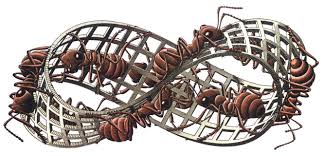Here is a worksheet going through the questions from today's lesson.
This video by Vi Hart is a wonderful story of a character named Wind who lives on a Möbius band and is having difficulty finding her friend, Mr. Ug. The story ends with a question that you should be able to answer after today's lesson.
- Wind and Mr. Ug by Vi Hart
- Wind and Mr. Ug: Part Two gives the answer to the question.
For more math related videos, visit the list of videos on Vi Hart's website.
Today we cut the Möbius in half and into thirds, getting very different results for each. We asked in the lesson what happens when you make different kinds of cuts for bands that have a certain number of twists. You should try this on your own. After you explore with paper and scissors, here are some answers:
In the lesson we used a fundamental domain consisting of a square and by pasting edges a pair of opposite edges we could (depending on whether we twist) make a circular band or a Möbius band. If we glue additional edges, we can make more shapes, including the sphere, the torus (or donut), the Klein bottle, and the projective plane (also called Boy's surface). You're probably familiar with the sphere and the torus. On the other hand, the Klein bottle and the projective plane are hard to visualize, and they have a number of cool and surprising properties. The following videos show you more about the Klein bottle and Projective plane.

The kinds of shapes we explored are related to figuring out the overall shape of our universe.
- A talk on The Shape of Space by Dr. Jeff Weeks
All of these ideas about shapes and how surfaces can be connected are explored in a mathematical subject called Topology. The Japanese mathematician Dr. Tadashi Tokieda gave a series of introductory lectures on Topology at the African Institute for Mathematical Sciences (AIMS) in 2014. The lectures start with easy material, but then the pace picks up quickly. You might find the first two lectures interesting and accessible. If you're curious, you can even check out Lecture 3 and more on YouTube.




















